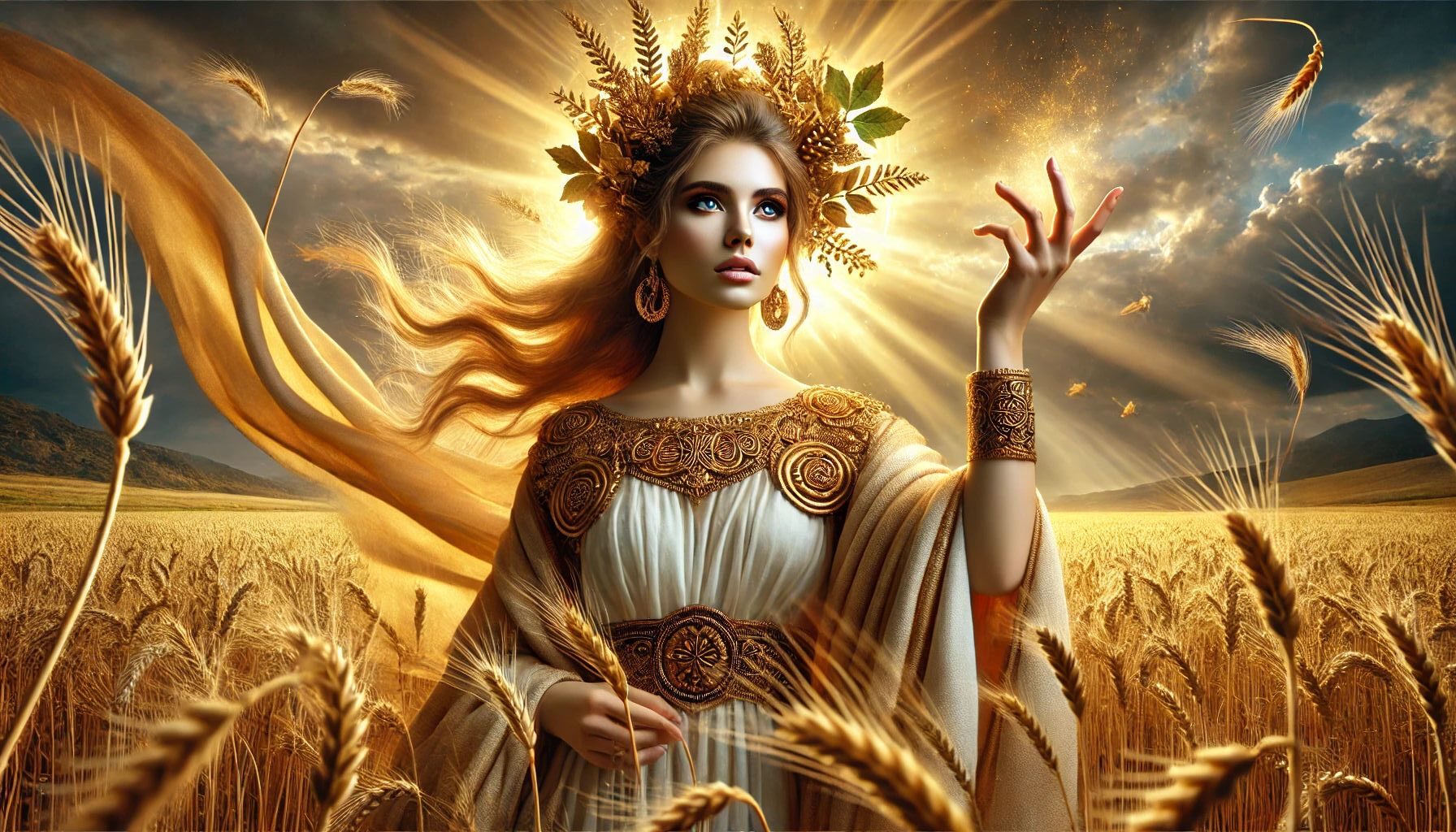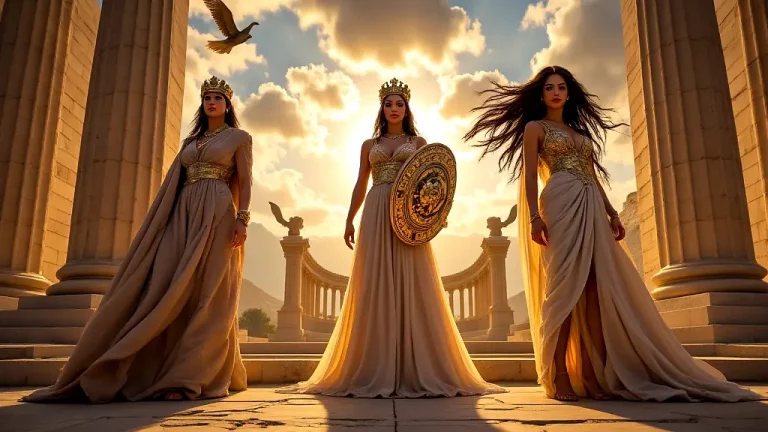Demeter: Greek Goddess Of Harvest, Agriculture, And Fertility
Within Greek myths, Demeter is an important figure. She represents the core of harvest, agriculture, and fertility. Think about a world where farming isn’t just work but also sacred rituals that make sure society survives and prospers. In ancient Greece, Demeter was the goddess who controlled growth of crops and land fertility. Today, farmers depend on seasons. The ancient Greeks depended on Demeter. Their fields being fertile? Their big harvests?
Key Points:
- Demeter is the Greek goddess in charge of harvest, agriculture, and fertility.
- Born from Titans Cronus and Rhea, she’s an essential member of the Greek gods’ family.
- Key symbols for Demeter are cornucopia, wheat sheaf, torch, and pig.
- Demeter’s most famous myth is about her daughter Persephone’s kidnapping by Hades, causing the earth’s barrenness and the change of seasons.
- The Eleusinian mysteries were secret religious events held to honor Demeter, promising spiritual renewal and a close connection to the gods.
- Ancient Greeks marked their respect to Demeter through farming practices and temples, affecting their societal norms.
- Demeter’s relationships with other gods, like Zeus, Poseidon, and Hades, reveal her role in Greek mythology and her impact on the natural world.
All thanks to her favor. As you jump into stories about Demeter, you will see her impact on both nature and those who honored her. From her divine roots to her key role in Persephone’s myth, Demeter’s story has deep emotional impact and lasting cultural importance.
Demeter: Overview and Key Facts
| Key Point | Description |
|---|---|
| Name | Demeter |
| Area | Harvest, Agriculture, Fertility |
| Signs | Cornucopia, Wheat, Torch, Pig |
| Parents | Cronus and Rhea |
| Siblings | Hestia, Hera, Hades, Poseidon, Zeus |
| Children | Persephone, Plutus, Arion |
| Main Stories | The kidnapping of Persephone, The big Eleusinian Mysteries |
| Worship | Worshipped a lot in ancient Greece, especially through farm festivals like Thesmophoria and Haloa |
| Importance | Key for understanding why seasons change and how farming cycles work |
| Temples and Sanctuaries | Many, like the famous sacred place at Eleusis |
Where Demeter Came From
To really see why Demeter is important, it’s necessary to look at her origins and family ties within the group of Greek gods. It’s crucial. Thus, considering Demeter’s background, and understanding her family, we grasp her importance within the Greek gods.
Demeter’s Birth and Family
Demeter’s parents were Cronus and Rhea, two of the Titans before the gods of Olympus. Think of a strong family where everyone has an important part in the cosmos. Demeter’s siblings, such as Hades and Poseidon, had their areas, like Hestia is the goddess of the hearth; Hera, is the queen of the gods; Hades, rules the underworld; Poseidon, oversees the sea; and Zeus, is the king of the gods.
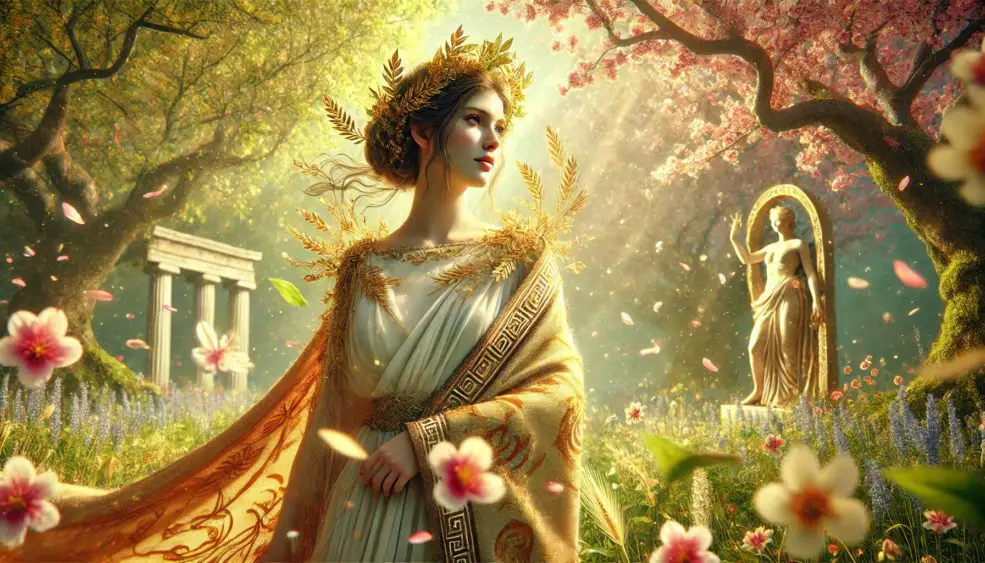
As one of the twelve gods of Olympus, Demeter’s role was key in keeping the earth fertile and farm work successful. Her spot in this divine family means her importance in Greek mythology, because she helped gods and people survive.
Demeter’s position in the divine family of Greek mythology was crucial for maintaining fertile land and successful farming, playing a vital role alongside other powerful gods like Zeus, Poseidon, and Hades.
Demeter’s Role in Greek Stories
Demeter’s main jobs, like taking care of harvests and farms, were very important to the ancient Greeks. They relied on her favor for their survival. Picture Demeter as the main caretaker of the earth, like a farmer today making sure crops grow and the land stays fruitful.
She was worshipped through various rituals and festivals, like Thesmophoria and Haloa, which marked the land’s fruitfulness and the cycles of planting and harvesting. It’s key. Her role was very important to Greek society because people thought she controlled the growth of crops and the fruitfulness of the soil, directly affecting food supply and community.
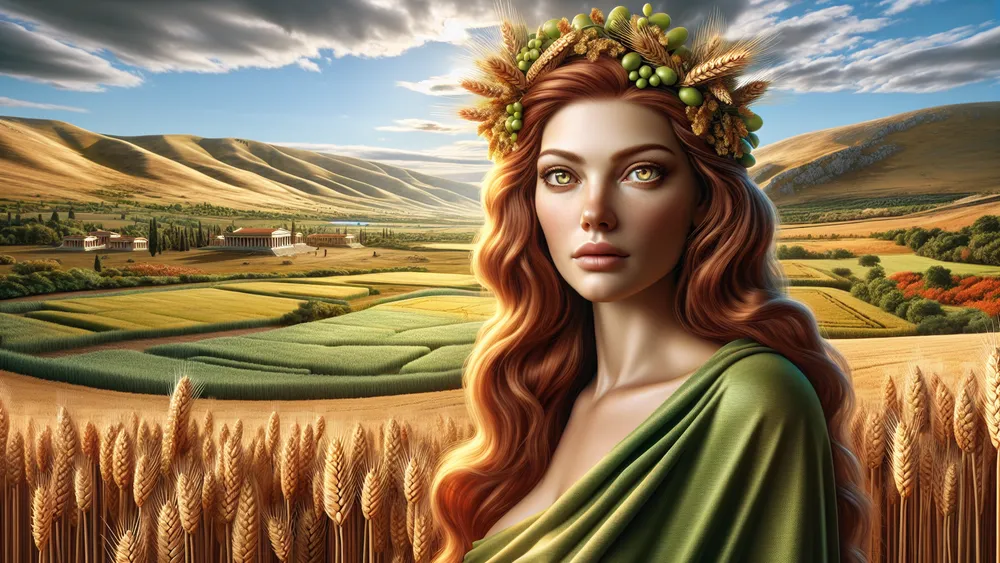
Throughout her stories and myths, Demeter’s influence went beyond farming, showing the nurturing forces of nature itself.
The Tale of Demeter and Persephone
One of the touching and important stories about Demeter is the tale of her daughter Persephone. This tale points out Demeter’s motherly love and tells how the seasons change.
The Kidnapping of Persephone
Persephone’s kidnapping starts with Hades, the god of the underworld, who fell in love with the beautiful Persephone, daughter of Demeter and Zeus. Without Demeter’s knowledge, Hades asked Zeus if he could marry Persephone. Zeus agreed, maybe for a political advantage or maybe he did not care about the consequences.
One day, while Persephone was picking flowers in a meadow, the ground opened up suddenly, and Hades came out in his chariot, grabbing her and taking her to the underworld. Think how scared Persephone was, suddenly taken away from the known world above to the dark, unknown place below. When Demeter found out her daughter was missing, her sadness was huge.
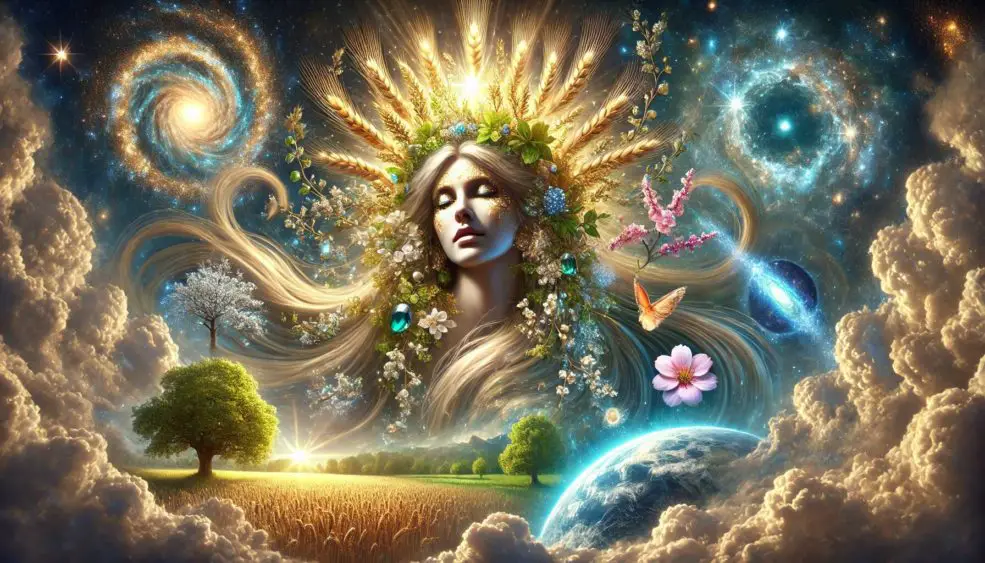
Think about the heartbreak of a mother searching desperately for her lost child, refusing to rest until she was found. Demeter wandered the earth for nine days and nights, neglecting her duties, and because of this, she caused the earth to become barren. Crops died, and famine spread among humans, meaning her deep sorrow. This emotional turmoil drove Demeter to go to Zeus, demanding her daughter back.
Her unending search and the barrenness of the earth meant the strong bond between mother and daughter and led to the compromise that would explain why the seasons change.
How It Affected Earth
Think of the earth mirroring Demeter’s sadness; while she mourned the loss of her daughter Persephone, the land itself began to wither and die. Fields, which once grew many crops, became barren, and the soil, which was fertile, became dry and hard. Trees lost their leaves, and flowers stopped blooming, showing Demeter’s deep sadness.
This stopped growth and fertility caused widespread famine among humans, who depended on the plenty of the earth for their survival. The myth clearly shows that Demeter’s emotional state directly affected the natural world, emphasizing her important role in the cycle of life and growth. The meaning of this myth is more than the immediate effect on agriculture; it also means an ancient explanation for the changing seasons.
When Persephone was allowed to come back to the surface for part of the year, her coming back to Demeter brought the renewal of the earth’s fertility. This pattern of Persephone going down into the underworld and returning to the earth above symbolizes the seasonal cycle of growth and decay.
Spring and summer mean the happy times when Demeter and Persephone are together, leading to great harvests and blooming landscapes. On the other hand, autumn and winter mean the time when Persephone is in the underworld, and Demeter’s sadness makes the earth cold and barren. This myth gave the ancient Greeks a way to understand and explain the natural rhythms of the seasons.

The Eleusinian Mysteries
Think about being in a special group that has secret events with deep religious meaning. The Eleusinian Mysteries were such events, held every year in the town of Eleusis to honor Demeter and Persephone. These mysteries were some of the most important religious events in ancient Greece. They attracted members from all over Greece.
Because the rites were covered in secrecy, and members were sworn to silence, much of their specific practices are unknown today. However, we do know that the events included several stages, starting with lesser mysteries in the spring and ending with the bigger mysteries in fall.
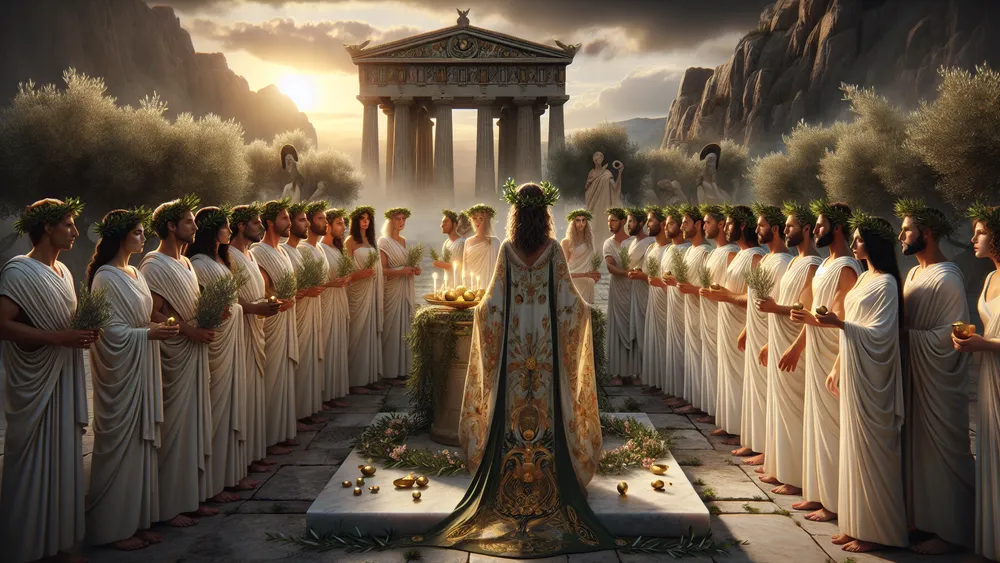
These stages had cleaning events, fasting, and dramatic performances of the myth of Demeter and Persephone, symbolizing life, death, and rebirth.
The importance of the Eleusinian Mysteries in ancient Greek religion was major. They were believed to offer members a deeper understanding of life and the afterlife, promising spiritual renewal and a closer connection to the gods. The key parts of these mysteries included:
- Cleaning events: Participants went through cleaning ceremonies to prepare for the sacred events.
- Fasting: They fasted to symbolize the mourning of Demeter and the barrenness of the earth.
- Dramatic shows: The myth of Demeter and Persephone was performed, telling themes of loss and reunion.
- Hidden teachings: Members received hidden knowledge that was believed to provide insights into the mysteries of life and death.
These parts together created a strong religious experience that left a lasting impact on participants, reinforcing the cultural and spiritual importance of Demeter and Persephone in ancient Greek society.
The Eleusinian mysteries in ancient Greece were secretive religious events with stages involving cleaning, fasting, dramatic performances, and hidden teachings, aiming to deepen members’ spiritual connection.
Symbols and Signs of Demeter
To understand how Demeter was important and present in ancient Greek times, it’s important to look into the different signs related to her. These signs help us see how she affected things and how she was honored. Thus, these signs show her influence and presence in ancient Greek culture. This way, they help us understand more about her importance.
Sacred Symbols and Animals
Demeter, the goddess of harvest and fertility, has many signs and animals linked to her. Think of the cornucopia, which is a horn full of fruits and vegetables, meaning plenty and food. The wheat sheaf is another key sign, standing for the main crop vital for food and linked directly to farming. The torch, which Demeter often has, means her long search for Persephone and the light she brings to the world.
Also, the pig is a special animal connected to Demeter, often offered during farming festivals to make sure everything grows well and a good harvest comes. Together, these signs and animals highlight Demeter’s key role in making sure the earth is fertile and people are well.
- Cornucopia: Means plenty and food.
- Wheat sheaf: Stands for farming and food.
- Torch: Means Demeter’s search for her daughter and bringing light.
- Pig: Special animal offered to ensure everything grows and a good harvest happens.
Demeter in Art and Stories
You can find Demeter in many artworks and books from ancient times, each pointing out her traits and stories well.
In old Greek art, Demeter appears as a mature woman, and she sometimes holds a sheaf of wheat or a torch, showing her link to farming and her search for Persephone. One well-known picture is the Eleusinian relief, which presents Demeter and Persephone together, showing their close bond.
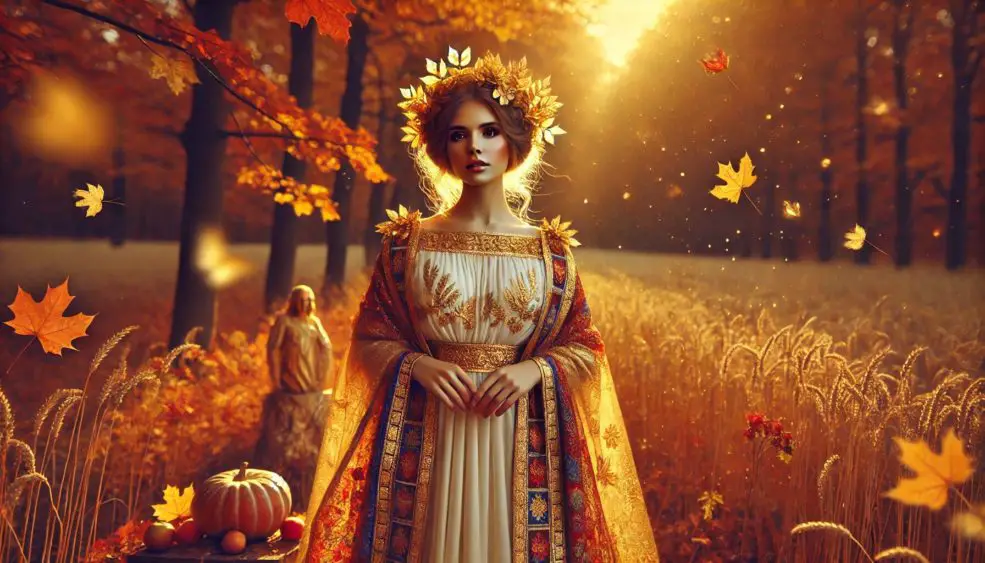
In writing, Demeter’s story mainly appears in “Homer’s Hymn to Demeter,” which tells the kidnapping of Persephone and Demeter’s deep sorrow and actions after that. This hymn not only points out her motherly traits but also shows how strong and important she is among the gods.
These images and stories help to show Demeter’s role as a caring yet powerful deity, central to old Greek views on life and nature’s cycles.
Demeter’s Impact on Farming and Society
Seeing Demeter’s effect in stories and art helps us know her big impact on old Greek farming ways and how communities lived. Let’s look at how people’s worship of her shaped farming and societal norms.
Farming Practices in Ancient Times
Think about living in ancient Greece, where crop success was needed for survival. The worship of Demeter was important in farming ways because people thought she controlled the land’s fertility. Farmers took part in events and festivals to honor her and make sure they had good harvests.
One festival was called Thesmophoria, which was held by women to promote fertility and crop growth. In this festival, women had secret rites where pig remains were buried, meaning fertility and rebirth. Another big festival was Haloa. Both men and women joined in and offered fruits, cakes, and sacrifices to Demeter.
These events were more than religious; they were also social activities that strengthened social bonds and showed the community’s dependence on the earth’s gifts.
Demeter’s Temples and Holy Places
Imagine going to these old places where the worship of Demeter was key to community life. These places were not only for worship but also for social and business activities. One very famous place is the Sanctuary of Demeter and Kore at Eleusis, near Athens.

This site was the center of the Eleusinian Mysteries, secret rites that promised members a better afterlife. Another important temple is the Temple of Demeter at Naxos, an architectural marvel that shows how much farming and fertility mattered in old Greek life. Many of these places were in fertile regions, highlighting Demeter’s role as the goddess of the harvest.
List of Temples/Sanctuaries
| Temple/Sanctuary | Location | Importance |
|---|---|---|
| Sanctuary of Demeter and Kore | Eleusis | Center of Eleusinian Mysteries, important religious rites |
| Temple of Demeter | Naxos | Architectural marvel, focuses on farming and fertility |
| Sanctuary of Demeter Malophoros | Selinunte | Known for its unique style and farming rituals |
| Temple of Demeter at Lycosoura | Arcadia | One of the oldest, important for its early worship rituals |
| Thesmophorion | Various cities | Places for Thesmophoria festival, promoting farm growth and fertility |
These temples and holy places were key in the worship of Demeter, showing her important part in making the land fertile and helping the people prosper.
Key temples and sanctuaries dedicated to Demeter played a crucial role in promoting fertility and prosperity through religious rituals centered around agriculture.
Demeter’s Connections with Other Gods
After looking at Demeter’s effect on farming and her sacred sites, it is important to understand her connections with other gods. This helps to explain her role in Greek mythology.
Demeter and Zeus
Think of Demeter and Zeus as key figures in a godly family roles, each with their own important parts. Demeter, the goddess of harvest and fertility, and Zeus, the king of the gods, had a complicated connection marked by both working together and fighting. They were siblings, both children of Cronus and Rhea, and also had a romance which led to the birth of Persephone, their most famous child.
Persephone’s abduction by Hades and Demeter’s grief, which caused the earth to become barren, is one of the best-known myths involving both Demeter and Zeus. Zeus’s role in this myth is many-sided; he allowed Hades to take Persephone at first but later stepped in to negotiate her partial return, thus restoring fertility to the earth.
This situation means how their domains are interconnected and their effect on both the divine and mortal worlds.
Demeter and Poseidon
Imagine the joining of two strong beings, each controlling different areas of nature. Demeter, the goddess of the harvest, and Poseidon, the god of the sea, had a unique and stormy connection. In the story, Poseidon went after Demeter, and she tried to evade him by transforming into a mare, but he turned into a stallion and caught her.

This led to the birth of two children: Arion, a godly horse with amazing speed, and Despoina, a goddess linked to mysteries and the underworld. This joining displays the interconnectedness of the earth and sea, symbolizing the fertility and life that both bring to the world.
The myth of Demeter and Poseidon shows the ancient Greeks’ understanding of the world’s complexity and the godly forces they thought controlled it.
Demeter and Hades
Picture a big family conflict that affects the whole world. This is the heart of the story of Demeter and Hades, which is about the story of Persephone. Hades, the god of the underworld, took Persephone, Demeter’s beloved daughter, with the silent approval of Zeus.
Because of her deep grief over the loss of her daughter, Demeter stopped doing her work, which made the earth barren and stopped all growth. This story means the changing seasons and shows the deep emotional bonds and tensions among the gods. The final deal, where Persephone spends part of the year with Hades and part with Demeter, symbolizes the cyclical nature of life and death, growth and decay.
Furthermore, it shows the lasting impact of divine relationships on the natural world.
Pantheon of Greek Mythology Gods
Think of a big family where each person has a unique role and job, and they all help the household work. This is like the Greek pantheon, a varied group of gods and goddesses, each ruling different parts of the natural and human world. Zeus, the king of the gods, and minor deities watching specific parts, together make the pantheon a complicated and connected system.
If you want to look into the full list of all Greek gods and their roles, you can go to this ultimate list of all the Greek mythology gods and goddesses. This complete list means understanding the many deities that filled ancient Greek religion and stories.

FAQs
1. Who were Demeter’s children besides Persephone?
Demeter’s children besides Persephone include Plutus and Arion.
2. What are the main festivals dedicated to Demeter?
The main festivals dedicated to Demeter include Thesmophoria, Haloa, and the Eleusinian Mysteries.
3. How did Demeter’s myths explain the changing seasons?
Demeter’s myths explain the changing seasons through her grief and joy over Persephone’s annual descent to and return from the underworld, causing the earth to become barren in her absence and fertile upon her return.
4. What are some lesser-known myths involving Demeter?
Some lesser-known myths involving Demeter include her transformation into a mare to escape Poseidon’s advances and her nurturing of the mortal Triptolemus, whom she taught the secrets of agriculture.

